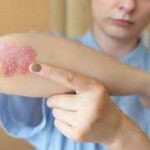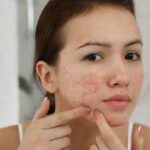In this blog post, we will delve into the various types of acne, exploring their underlying causes and shedding light on effective treatment options. Let’s dive in!
Acne is a common skin condition that occurs when hair follicles (tiny holes in the skin) become plugged with oil and dead skin cells. This skin disease most commonly occurs in adults or teenagers but can affect people of any age. Acne does not pose a serious risk to your overall health, but over time, it might cause scarring and discolouration of the skin.
Acne can be found anywhere on the body, but the most specific locations of its occurrence include the face, neck, back, nose, and shoulder. There are a variety of treatment options available to treat acne and help reduce the number of pimples and the possibility of scarring.
What Are The Symptoms of Acne?
Symptoms of acne are usually seen on the face, but other parts of the body can also be affected, such as the back, shoulders, and chest. When acne develops on any body part, the skin around it becomes red and inflamed.
Some of the symptoms of acne include the following conditions:
- Red spots or swelling in the skin
- Inflamed skin filled with pus
- Dark spots with open pores at the centre (blackheads)
- Tiny white bumps (whiteheads) under the skin
- Red swelling or lumps
- Deep pustules and cysts

Causes of Acne
Acne most often appears on the face, neck, chest, and shoulders because these areas of the skin have the most oil glands. It is caused when overactive sebaceous glands release too much oil, which, when combined with dead skin cells, blocks the pores and leads to inflamed eruptions.
Let’s see the other most common causes of acne:
- Hormonal changes during puberty affect sebum production and cause acne to develop.
- Stress and anxiety stimulate the oil glands and increase oil production and pores, which make acne worse.
- Some medications that contain androgens, corticosteroids, and lithium can be the reason behind the development of acne in a person.
- Foods such as dairy products, potatoes, rice, bread, and sweets, when consumed regularly, also lead to oil development in the skin, which over time turns into acne.
Want to know what’s triggering your acne? Read here about some common triggers!
Different Types of Acne
- Fungal acne
Fungal acne, also known as Pityrosporum folliculitis, appears as small pimples on the body that come along with itching. It is a common skin condition that develops when hair follicles get infected with a fungus called Malassezia yeast. Fungal acne is a skin condition that is caused by a fungal infection in the hair follicles.
Causes
Fungal acne mostly appears on the shoulders, back, and neck due to excessive sweating. Signs and symptoms of fungal acne include itchy skin, red bumps, spots, and irritated hair follicles.

What causes fungal acne?
- Living in a hot and humid climate
- Frequent sweating
- Having high oil gland production
- Wearing tight and restrictive clothing
- Cystic Acne
It is a serious and inflammatory type of acne that causes painful, deep, pus-filled pimples and nodules under the skin. Cystic acne usually occurs in people with oily skin, but anyone can be affected by this type of acne type. Most teens, women, and older adults with hormonal imbalances can develop cystic acne.
What causes cystic acne?
-Hormonal fluctuations
-Genetics
-Diet
-Stress
-Exposure to certain pollutants & chemicals
3. Hormonal Acne
Hormonal acne occurs due to fluctuations in the body’s hormones. Most likely, it appears during puberty but can affect people of any age. The prime locations of hormonal acne are the forehead and nose bridge because the sebaceous glands are in the T-zone. However, it can also develop in the cheek and jawline areas.
What Causes Hormonal Acne?
Hormonal acne occurs when the skin increases its oil production due to hormonal changes. After that, the oil interacts with the bacteria present in the skin’s pores, resulting in acne.
Some of the common causes of hormonal acne include the following:
- Dead skin cells
- Lack of sleep
- Excess production of sebum
- Bacteria
CONCLUSION
Acne is a common skin condition among teenagers and young adults. It occurs when tiny holes on the surface of the skin, known as pores, get blocked or clogged. There are various different types of acne that commonly affect people. Some of the common symptoms of acne include red spots, swelling, and bumps in the skin. However, signs and symptoms may vary depending on the severity of the disease.
Reach out to Ayursparsh Clinic and Panchakarma Centre for treating your skin diseases, such as acne, eczema, and psoriasis. Do consult Dr. Rashmi Patil, who gives personalised treatment for your acne type.




